CONSECRATION OF THE CHURCH (Jn 10:22-44)
"Then I, John, saw the Holy City, New Jerusalem, coming down out of heaven from God, prepared as a bride adorned for her husband." (Rv 21:2)
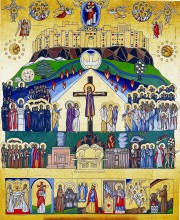 The Consecration of the Church icon is a literal historical, biblical and Antiochene representation of the Church- the dwelling place of God with people and the eternal seat of His glory. The lowest section of the icon depicts symbols of the church, whereas the next row up represents Old Testament history of the People of God. In the center of the icon is portrayed the Crucifixion, in Syriac style. Rising above the cross is the symbol of Trinity. To the right is depicted the One, Holy, Catholic and Apostolic Church. To the left is the Syro-Maronite Antiochene Church, Peter, Paul and the apostles, martyrs and confessors and the whole communion of saints, the Syriac Church Fathers, the founders and people of the Maronite Church.
The Consecration of the Church icon is a literal historical, biblical and Antiochene representation of the Church- the dwelling place of God with people and the eternal seat of His glory. The lowest section of the icon depicts symbols of the church, whereas the next row up represents Old Testament history of the People of God. In the center of the icon is portrayed the Crucifixion, in Syriac style. Rising above the cross is the symbol of Trinity. To the right is depicted the One, Holy, Catholic and Apostolic Church. To the left is the Syro-Maronite Antiochene Church, Peter, Paul and the apostles, martyrs and confessors and the whole communion of saints, the Syriac Church Fathers, the founders and people of the Maronite Church.
One of the distinguished emblems, above the (symbol) of the Antioch Church is the emblem of the Maronite Patriarchate. On the opposite side we see the Tree of Life with twelve fruits for the healing of nations and the seven fruits for the sacraments of the church. From the Throne of God runs the River of Life; whereas the mountain, the fire and the natural phenomena depict theophany- the visible manifestation of God to man.
The colors are symbolic too- gold for eternity; red for martyrdom and kingship; blue for heaven; white for purity and green for creation. The sun with twelve stars represents the New Testament Church, Christ and the Apostles. The moon and twelve stars stand for the Old Testament Church, the patriarchs and our Lady.
The top of the icon shows the New Jerusalem, the eternal bride of Christ, to whom Christ comes in glory, to make His dwelling place forever.
ANNUNCIATION TO ZACHARIAS (Lk 1:1-25)
"Do not be afraid , Zacharias, for your prayer is heard…" (Lk 1:13)
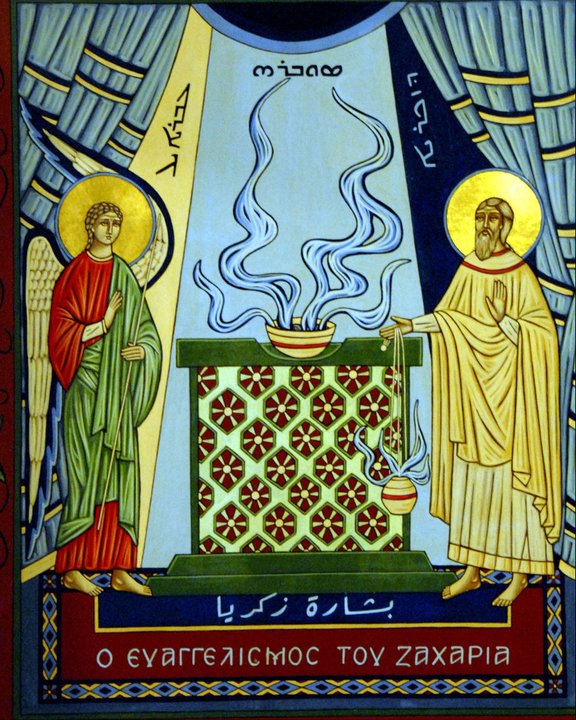 Here, in the Nativity Cycle, the drama of the announcement of a forthcoming son to the aged and barren Elizabeth and Zacharias is emphasized by the simplicity of the composition, the movement of the lines from top to bottom- from heaven to earth- and the strength of the colors. The shades of blue and gold, reaching down from Heaven, symbolize eternal light and the illumination of divine revelation. The Altar of Incense- the holy place of liturgical prayer- is symbolically placed in the center. To the right, stands priest Zacharias, and to the left, stands Archangel Gabriel who proclaims the news of the birth of the Forerunner, and pronounces sentence upon Zacharias for his lack of faith.
Here, in the Nativity Cycle, the drama of the announcement of a forthcoming son to the aged and barren Elizabeth and Zacharias is emphasized by the simplicity of the composition, the movement of the lines from top to bottom- from heaven to earth- and the strength of the colors. The shades of blue and gold, reaching down from Heaven, symbolize eternal light and the illumination of divine revelation. The Altar of Incense- the holy place of liturgical prayer- is symbolically placed in the center. To the right, stands priest Zacharias, and to the left, stands Archangel Gabriel who proclaims the news of the birth of the Forerunner, and pronounces sentence upon Zacharias for his lack of faith.
ANNUNCIATION TO THE VIRGIN MARY (Lk 1:26-38)
"Rejoice, highly favored one, the Lord is with you, blessed are you among women." (Lk 1:28)
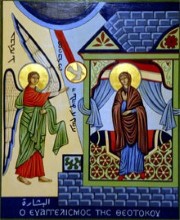 This icon is rich in Syriac tradition design and color. It symbolizes the joy of the announcement to Mary, that she will be the Mother of God.
This icon is rich in Syriac tradition design and color. It symbolizes the joy of the announcement to Mary, that she will be the Mother of God.
The Virgin Mary stands in her house of prayer, portrayed in a posture of submission and acceptance, filled with joy and peace at the message of the Angel. The Holy Spirit is depicted in the form of a dove, descending upon her in his great act of divine mystery. To the left of the icon, we see Archangel Gabriel, stretching out his right hand to the Virgin Mary, in both proclamation and blessing. With his left hand, he holds the angelic staff. The blue semi-circle at the top of the icon, as depicted in all the icons of this series, symbolically represents the realm of the Divine and the presence of God the Father.
VISITATION OF MARY TO ELIZABETH ( Lk 1:39-45)
"My soul magnifies the Lord, and my spirit has rejoiced in God my Savior." ( Lk 1:46)
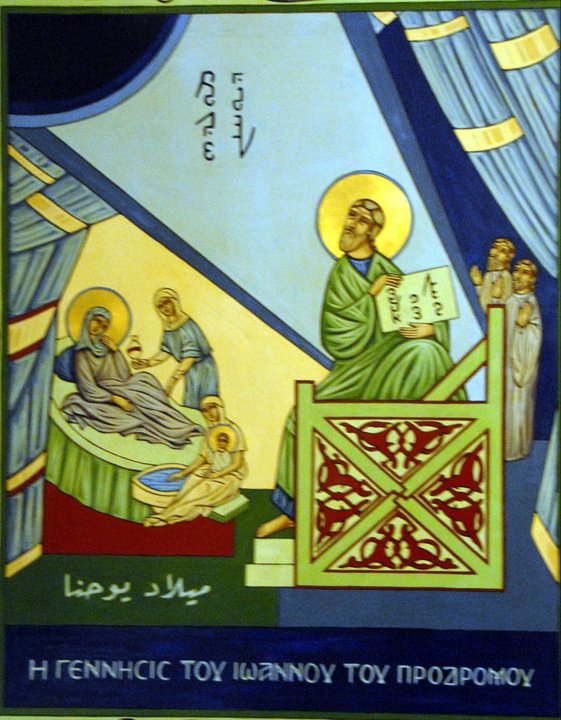 In striking simplicity, Mary and Elizabeth meet in a mutual embrace, exchanging joy at the mystery of two miraculous conceptions: one human and the other divine.
In striking simplicity, Mary and Elizabeth meet in a mutual embrace, exchanging joy at the mystery of two miraculous conceptions: one human and the other divine.
We see in the background the mountains hill country of Judah, where Elizabeth lived. To the right and left, there are two houses symbolizing the homes and lineages of Mary and Elizabeth. The curtains signify a holy place and the presence of prayer. This icon is bathed in shades of blue, representing the colors of heaven.
BIRTH OF JOHN THE BAPTIST ( Lk 1:57-66)
"And you, child, will be called the prophet of the Highest; for you will go before the face of the Lord, to prepare His ways." ( Lk 1:76)
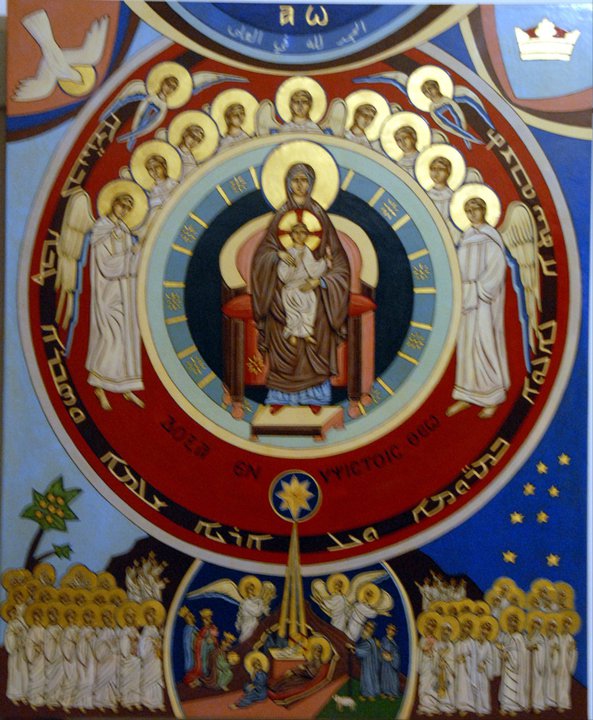 This icon portrays the fulfillment of the promise of the angel to Zacharias. This joyful event is depicted in a traditional manner, especially in the background of the icon, where we see Elizabeth giving birth and all what surrounds it. The family is bathed in heavenly joy.
This icon portrays the fulfillment of the promise of the angel to Zacharias. This joyful event is depicted in a traditional manner, especially in the background of the icon, where we see Elizabeth giving birth and all what surrounds it. The family is bathed in heavenly joy.
John is shown as conscious of his future role as Forerunner of Christ. Zacharias holds the central place, seated in the chair of prophecy, as the revelation from heaven descends upon him. Zacharias writes "His name is John", at that moment his tongue is loosened and he speaks praising God. This icon is full of greens, representing peace on earth and the revelation of God.
REVELATION TO JOSEPH (Mt 1: 18-25)
"He made him overseer of his house, and all that he had put in his hand." (Gen 39:4)
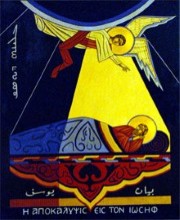 We see in this icon, which dramatizes a single event, two personages: Joseph laying in a disturbed sleep of doubt; and the angel, reaching down to him out of heaven, with a message of hope and faith.
We see in this icon, which dramatizes a single event, two personages: Joseph laying in a disturbed sleep of doubt; and the angel, reaching down to him out of heaven, with a message of hope and faith.
The black color symbolizes the profound inner conflict and spiritual darkness, which is also an expression of human pain. Into the depths of the human’s need and confusion come the rays of divine light, which fills the hearts with hope comfort and healing, carried by a message from God.
GENEALOGY OF OUR LORD ( Mt 1:1-17)
"Rain down, you heavens, from above, and let the skies pour down righteousness." ( Is 45:8)
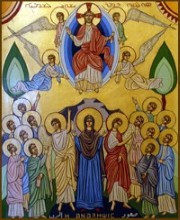 In this icon, the genealogy of Our Lord is represented as the tree of Jesse, out of which grows the Messianic branch (Is 11:1). At the lower part of the tree, at the top of the trunk, is depicted Adam, the first man created in the image of God; at the top of the tree is Christ, the Perfect second Adam, born to redeem and save lost mankind. Between Adam and Christ are portrayed the most significant in the human line of genealogy. The entwining branches and leaves represent the fourteen generations from Abraham to Christ. We also see, in the top of the icon, portray of the Holy Trinity. God the Father is depicted by a Divine Hand reaching down into human history. In the center, at the top of the tree, is Christ the incarnate Son of God. At the top right is represented the Holy Spirit, in the form of a dove. As for the shades of blue, they stand for the divine presence of God and for eternal light. The blues also stand for heaven and the greens for earth, as heaven and earth meet in genealogy of the Son of God.
In this icon, the genealogy of Our Lord is represented as the tree of Jesse, out of which grows the Messianic branch (Is 11:1). At the lower part of the tree, at the top of the trunk, is depicted Adam, the first man created in the image of God; at the top of the tree is Christ, the Perfect second Adam, born to redeem and save lost mankind. Between Adam and Christ are portrayed the most significant in the human line of genealogy. The entwining branches and leaves represent the fourteen generations from Abraham to Christ. We also see, in the top of the icon, portray of the Holy Trinity. God the Father is depicted by a Divine Hand reaching down into human history. In the center, at the top of the tree, is Christ the incarnate Son of God. At the top right is represented the Holy Spirit, in the form of a dove. As for the shades of blue, they stand for the divine presence of God and for eternal light. The blues also stand for heaven and the greens for earth, as heaven and earth meet in genealogy of the Son of God.
CHRISTMAS NOVENA ( Is 9:2-6)
"The people who walked in darkness have seen a great light; upon those who dwelt in the land of gloom, a light has shone." ( Is 9:2)
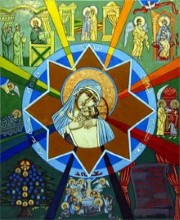 The icon of Christmas Novena is the icon of the mystery of Incarnation, with our Lady and the infant Jesus at the center, enfolded in an eternal embrace and encased in the star of the Father's love and divinity. From this star emanate rays of eternal light, symbolically represented by a gradual movement of the refracted colors of the rainbow- the sign of God's covenant with man. (cf Ge 9:16-17)
The icon of Christmas Novena is the icon of the mystery of Incarnation, with our Lady and the infant Jesus at the center, enfolded in an eternal embrace and encased in the star of the Father's love and divinity. From this star emanate rays of eternal light, symbolically represented by a gradual movement of the refracted colors of the rainbow- the sign of God's covenant with man. (cf Ge 9:16-17)
Between the rays of starlight are depicted the events preceding and heralding the coming of Our Lord. We also read in the Syriac inscription all the names of Christ, from the prophecy of Isaiah: “For unto us a child is born, unto us a Son is given…and His name will be called Wonderful, Counselor, Mighty God, Everlasting Father, Prince of Peace…” ( Is 9:6)
NATIVITY OF THE LORD ( Lk 2:1-20)
"Behold, a virgin, shall be with a child, and bear a Son and they shall call His name Emmanuel," which is translated, "God with us." (Mt 1:23; Is 7:14)
 This icon of the Nativity is in honor of the Virgin Mary and her unique role in the mystery of the Incarnation. Around the oval mandala, containing the representation of the Nativity, depicted in decorative form, are shown many of the symbols of Our Lady and of the Incarnation that are found in the Holy Scriptures and described in the old Syriac Hymns of the Church, especially those of St. Ephraim. The angels, descending form heaven, act as attendants at this Holy Birth and as deacons at this sacramental mystery. Their hands are covered with cloths, in reverence and service to the Christ Child. Two angels reach down from heaven to announce the good news of the birth of a Savior; the simple, poor shepherds gladly respond. Joseph contemplates the awesomeness of this event. God is born a man.
This icon of the Nativity is in honor of the Virgin Mary and her unique role in the mystery of the Incarnation. Around the oval mandala, containing the representation of the Nativity, depicted in decorative form, are shown many of the symbols of Our Lady and of the Incarnation that are found in the Holy Scriptures and described in the old Syriac Hymns of the Church, especially those of St. Ephraim. The angels, descending form heaven, act as attendants at this Holy Birth and as deacons at this sacramental mystery. Their hands are covered with cloths, in reverence and service to the Christ Child. Two angels reach down from heaven to announce the good news of the birth of a Savior; the simple, poor shepherds gladly respond. Joseph contemplates the awesomeness of this event. God is born a man.
10- PRAISES OF THE MOTHER OF GOD ( Lk 1:46-55)
"Rejoice, highly favored one, the Lord is with you; blessed are you among women." ( Lk 1:28)
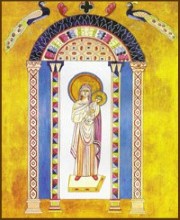 To celebrate the day after Nativity, the "Praises of the Mother of God," this icon exalts the Virgin Mary for her virtues, and for her central role in the mystery of incarnation as the mother of God, the Mother of Light. And as Jesus is the new Adam, so Mary is the new Eve.
To celebrate the day after Nativity, the "Praises of the Mother of God," this icon exalts the Virgin Mary for her virtues, and for her central role in the mystery of incarnation as the mother of God, the Mother of Light. And as Jesus is the new Adam, so Mary is the new Eve.
This icon illustrates well the hymns of Saint Ephrem in honor of Our Lady. The Virgin Mary holds the central place, bearing her divine Son on her lap. She is enclosed, with Him, within concentric circles of shades of turquoise blue- signifying eternity and divinity. Around her are gathered the angelic hosts, who bear her honor. At the top of the icon, we see symbols of the Holy Trinity. In the center is the segment of a circle in shades of blue, on which is painted in gold the Greek letters A "alpha" and Ω "omega"- the beginning and the end- to indicate God the Father. To the left, we seethe symbol of a dove, depicting the Holy Spirit. To the right is a crown, representing the glory of heaven, which the eternal Son left in order to become a man for our sake, but to which He will return again. On the left and right of the icon are the colors of day and night and the cosmic elements, as well as the Tree of Life bearing the Seven Sacraments of the Church. At the bottom, is a representation of the Nativity. To the lower right and left of the icon we see hosts of heaven, the shepherds, and the magi, the apostles, martyrs, confessors church fathers, saints, priests and the faithful, dressed in white who offer their praises today and for eternity. The strong reds, blues and gold represent kingship and glory and never-ending light.
CIRCUMCISION: THE DAY OF PEACE ( Lk 1:46-55)
"In His days the righteous shall flourish, and abundance of peace, until the moon is no more." ( Ps 72:1)
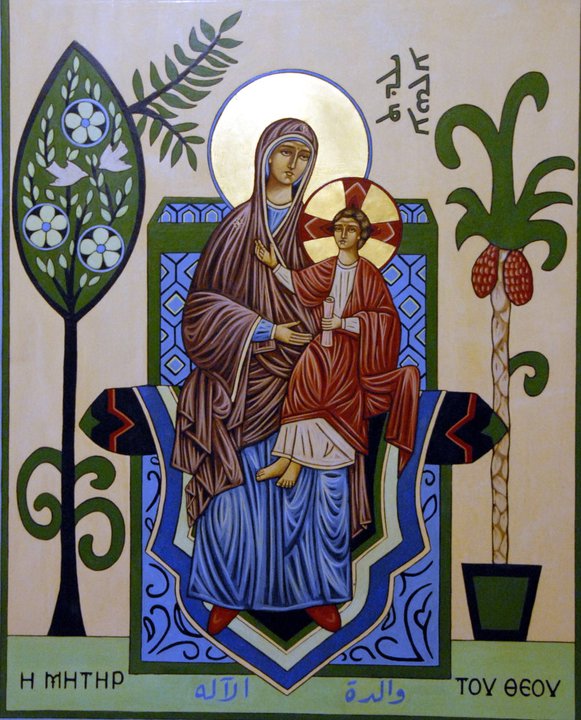 The icon of Our Lady is chosen to celebrate the first Sunday after Christmas, the feast of circumcision, and the first day of the New Year, the "Day of Peace."
The icon of Our Lady is chosen to celebrate the first Sunday after Christmas, the feast of circumcision, and the first day of the New Year, the "Day of Peace."
On the lap of His Mother sits the Christ Child, full of the wisdom of the eternal Deity, His right hand raised in a gesture of blessing. Virgin Mary is seated upon a throne, decorated in an ancient Syriac design, symbolizing her role as Queen of heaven and earth and also reflected in the choice of colors. Behind them is an olive tree, symbol of peace and also symbol of the Church. Two white doves, also representing peace, hover in the branches of the tree. The blues and greens symbolize heaven and earth and the peace that is found in the face of Our Lady and in the gesture of her Son.
FINDING OF OUR LORD IN THE TEMPLE ( Lk 2:41-52)
"Why is it that you sought me? Did you not know that I must be about my Father's business?" ( Lk 2:49)
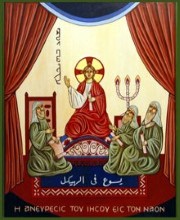 The last icon of the Nativity Cycle, for the second Sunday after Christmas, features the Finding of Our Lord in the Temple, amongst the Doctors of Law. In this icon, Christ is represented as young in years, but filled with the wisdom of all eternity. Seated upon a decorative platform, He is raised above the religious teachers, who sit in the posture of students at His feet, amazed at His learning and teaching. They hold scrolls which represent the Old Testament Law and Prophets, while Christ Himself, the living Word of God, is the fulfillment of the law and the prophecies, in Person.
The last icon of the Nativity Cycle, for the second Sunday after Christmas, features the Finding of Our Lord in the Temple, amongst the Doctors of Law. In this icon, Christ is represented as young in years, but filled with the wisdom of all eternity. Seated upon a decorative platform, He is raised above the religious teachers, who sit in the posture of students at His feet, amazed at His learning and teaching. They hold scrolls which represent the Old Testament Law and Prophets, while Christ Himself, the living Word of God, is the fulfillment of the law and the prophecies, in Person.
EPIPHANY- BAPTISM OF OUR LORD (Mt 3:13-17)
"And the light shines in the darkness, and the darkness did not comprehend it." ( Jn 1:5)
 In this icon of the Baptism, Christ receives baptism at the hands of John the Baptist, the last of the prophets of the old Covenant. Here, the Old and New Covenants meet in the water of the Jordan- the old baptism for repentance of sins, and the lasting baptismal rebirth of water and the spirit, as brought by Jesus in the New Covenant (Lk 3:16). For this reason, the bottom of this icon depicts symbols of the initiation Sacraments of the Christian Church- Baptism, Chrismation and the Eucharist. On either side are representations of confirmation of the Holy Spirit in purifying water: the Spirit of God hovering over the waters in creation (Ge 1:2), and the traditional "Blessing of the Waters" with the Cross in the Epiphany liturgy. In this icon of the Baptism, Christ is stripped of His eternal robe of glory and naked, is robed in the waters of the Jordan which itself shines forth with the beams of His glory and light. Here, He is clothed in our humanity, that we, in our baptism, might be clothed in His eternity. The symbol of the sun and the moon represent the cosmic light that Christ brings on his Feast of Epiphany.
In this icon of the Baptism, Christ receives baptism at the hands of John the Baptist, the last of the prophets of the old Covenant. Here, the Old and New Covenants meet in the water of the Jordan- the old baptism for repentance of sins, and the lasting baptismal rebirth of water and the spirit, as brought by Jesus in the New Covenant (Lk 3:16). For this reason, the bottom of this icon depicts symbols of the initiation Sacraments of the Christian Church- Baptism, Chrismation and the Eucharist. On either side are representations of confirmation of the Holy Spirit in purifying water: the Spirit of God hovering over the waters in creation (Ge 1:2), and the traditional "Blessing of the Waters" with the Cross in the Epiphany liturgy. In this icon of the Baptism, Christ is stripped of His eternal robe of glory and naked, is robed in the waters of the Jordan which itself shines forth with the beams of His glory and light. Here, He is clothed in our humanity, that we, in our baptism, might be clothed in His eternity. The symbol of the sun and the moon represent the cosmic light that Christ brings on his Feast of Epiphany.
DECEASED PRIESTS ( Lk 12: 42-48)
THE RIGHTEOUS AND JUST ( Mt 25:31-47)
THE FAITHFUL DEPARTED( Lk 16:19-31)
"Blessed are the dead who die in the Lord…" (Rv 14:13)
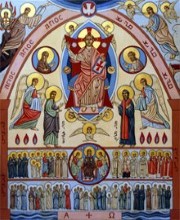 This icon celebrates, memorials to the Three Sundays of the Deceased Priests, the Righteous and Just and the Faithful Departed. At the top left of the icon is depicted the giving of the Law to Moses on Mount Sinai, beside the burning bush, typifying the Virgin Mary and symbolizing the holiness and call of God (Ex 3:19; 32:18). On the top right is the vision of the prophet Isaiah in the Temple.
This icon celebrates, memorials to the Three Sundays of the Deceased Priests, the Righteous and Just and the Faithful Departed. At the top left of the icon is depicted the giving of the Law to Moses on Mount Sinai, beside the burning bush, typifying the Virgin Mary and symbolizing the holiness and call of God (Ex 3:19; 32:18). On the top right is the vision of the prophet Isaiah in the Temple.
Within the apse is depicted Christ , the Pantocrator, sitting in glory and judging upon the sons of men, and surrounded by the church in heaven. His throne is carried by the four non-bodied cherubim of the Apocalypse, symbolizing the four Evangelists. In the deistic position of intercession, to the right of Christ, are His Mother and John the Baptist. Beneath them are the Archangels Michael and Gabriel, kneeling before Him in adoration. Completing the circle are the figures of St. Peter and St. Maron. Around the apse is written in Syriac, "Blessed are the dead who die in the Lord…" (Rv 14:13).
On the lower levels of the icon are represented those from the Church on earth, who rest in death. In the center of the upper panel is a circle representing Our Lady flanked by two angels. On the right is a panel depicting the Priests of the church; on the left are shown the ranks of the Righteous and Just. On the lower panel, are represented the Faithful Departed, whom we love, for whom we pray and whom we especially remember on this day.
WEDDING AT CANA OF GALILEE ( Jn 2:1-12)
"Blessed are those who are called to the marriage supper of the lamb!" ( Rv 19:9)
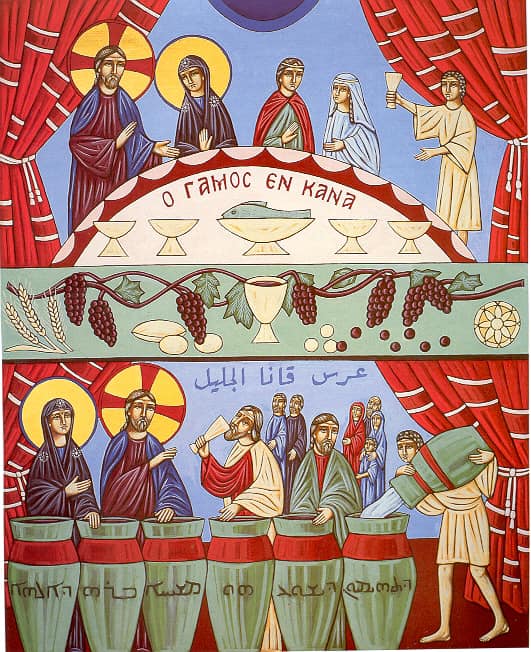 This first miracle of Our Lord, changing the water into wine at the marriage feast in Cana, is the theme of the Entrance Sunday into Lent. This event is depicted in this icon on two levels, with a symbolic decorative panel dividing them. The higher level represents the marriage feast, with Our Lord seated in honor on the left and his Mother positioned between Him and the Bridegroom and Bride. She is the Mediator and Intercessor on behalf of humanity and it is she who brings to the attention of Her Son the fact that the wine has run out. In the lower level, Christ is standing to the left of His Mother, who tells the servants to do whatever He commands them. They pour water into the water jugs which symbolize the vessels of human lives, filled with the new wine of Spirit. In the background, the wedding guests stand, observing and participating, and they represent the senses.
This first miracle of Our Lord, changing the water into wine at the marriage feast in Cana, is the theme of the Entrance Sunday into Lent. This event is depicted in this icon on two levels, with a symbolic decorative panel dividing them. The higher level represents the marriage feast, with Our Lord seated in honor on the left and his Mother positioned between Him and the Bridegroom and Bride. She is the Mediator and Intercessor on behalf of humanity and it is she who brings to the attention of Her Son the fact that the wine has run out. In the lower level, Christ is standing to the left of His Mother, who tells the servants to do whatever He commands them. They pour water into the water jugs which symbolize the vessels of human lives, filled with the new wine of Spirit. In the background, the wedding guests stand, observing and participating, and they represent the senses.
The central decorative panel depicts the Body and Blood of Christ, as the wedding feast is symbolic of the Holy Eucharist and a foretaste of the eternal Marriage Feast of the Lamb with His Holy Bride, the Church ( Rv 19:7; 21:1).
